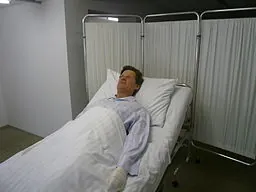Blunt Chest Trauma Can Cause Bone Injuries
The bones are the most likely structures to be injured after blunt chest trauma. They are on the outside of the chest cavity and generally protect the underlying structures. The bones that are likely to be injured include those discussed here.
Sternal Fracture
This is a fracture of the breastplate. It usually happens when there is a high energy impact to the front part of the chest wall during a motor vehicle accident when the driver’s chest hits the steering wheel or there is a sudden deceleration injury that causes an occupant’s head to slam against the shoulder part of the seat belt.
The degree of displacement of the sternal fracture correlates with the risk for associated injury to the inside of the chest, even though nondisplaced fractures still can carry a risk for internal chest injuries. Common injuries seen along with a sternal fracture include a head injury, fractured ribs, lung contusion, blood clot behind the sternum, spinal fracture, pneumothorax, hemothorax, and trauma to the extremities. Aortic ruptures, blood around the heart, and bruising of the heart can also occur.
Chest x-rays can only pick up on a sternum fracture about half the time. Lateral views can help improve the ability to see these fractures. CT scanning is the most sensitive of all the tests but there is no real gold standard for detecting these fractures. If a sternal fracture is seen on a plain x-ray, then a CT scan and an EKG should be done looking for other injuries. Cardiac biomarkers may also be indicated.
In a stable patient with a nondisplaced sternal fracture and no findings on EKG, there is no need for further cardiac workup. Many patients can be safely sent home as long as someone responsible will stay with the patient and adequate follow up is taken care of. The elderly, those in severe pain, and those with intrathoracic findings should be admitted to the hospital in order to be observed. Some sternal fractures need to be fixed in the operating room while others can heal spontaneously if not displaced.
Scapular Fractures
These require significant force in order to be fractured and a fracture of the scapula should raise the index of suspicion that other injuries are present. They are usually seen in motor vehicle crashes and in falls from a great height. Other injuries often seen at the same time include spinal fractures, rib fractures, clavicle fractures, chest injuries (inside the chest), liver injuries, splenic injuries, and fractures of the tibia (in pedestrian motor vehicle injuries).
A CT scan of the chest should probably be done in any patient with a scapular fracture after blunt chest trauma because the forces involved are extreme and the risk of other injuries is high. There should also be a consultation with a trauma surgeon and an orthopedist. If the chest CT scan and other evaluations are negative, the patient may be discharged with medications for pain.
Rib Fractures
If there are more than three rib fractures, especially in older patients, there is a great risk for complications, such as bruising of the ribs and pneumonia, even if other injuries are absent. They should probably be admitted to the hospital for observation. If the individual is young and healthy, however, and has been observed for a while, they may probably be discharged from the hospital safely.
Flail Chest
This happens when three or more adjacent ribs are fractured in two different places, creating a floating section of the chest wall. The unstable part of the chest wall shows paradoxical motion and moves in the opposite direction of the uninjured, normal functioning chest wall during breathing. The incidence of bruising of the lung is very great with this type of injury. The abnormal movements of the chest wall may be difficult to see, especially in large people.
These patients need oxygen and close monitoring for signs of respiratory distress, using pulse oximetry and CO2 monitoring. Direct pressure to stabilize the segment will interfere with chest expansion and is therefore not usually done. Positive airway pressure using a mask may prevent intubation in adults who are otherwise conscious. Patients with severe injuries, worsening respiratory function, and respiratory distress may need mechanical ventilation.
Sternoclavicular Dislocation
This is a separation of the joint between the collar bone and the breastplate. It is caused by direct, high impact blow to the medial portion of the clavicle so that it separates from the sternum. The dislocation can be in any direction.
The most serious injury comes from a posterior dislocation of the sternoclavicular joint. This can compress the trachea, lacerate blood vessels, and damage the lung, causing a pneumothorax. It can also damage the laryngeal nerve so that the patient becomes hoarse. It is important to check the pulses in the arteries of the upper extremity on the side of the injury.
It is difficult to diagnose using plain x-rays. Special views can be used but a CT scan is better for diagnosing the injury.
As for treatment, anterior subluxations require no immediate treatment. If the area is truly dislocated, however, it should be put back into position within 12-24 hours. This can usually be done by an orthopedic surgeon on an outpatient basis.
Posterior dislocations are very difficult to put back into proper position after 24 hours so it must be diagnosed early and can be reduced using sedation in the emergency department by an orthopedic surgeon. If the airway is compromised by the dislocation, however, it may need to be reduced by the emergency room doctor. Bleeding from a blood vessel injury may be seen as a blood clot underneath the clavicle and this may need evaluation by a vascular specialist. n
I’m Ed Smith, a Sacramento Injury Lawyer since 1982. Call me anytime for free, friendly advice at 916-921-6400.
See our Reviews on Yelp and Avvo.
Member of Million Dollar Advocates Forum.

